#hakalau forest
Text

An 'i'iwi or scarlet honeycreeper (Drepanis coccinea) feeds on flowers in the Hakalau Forest Wildlife Refuge, Hawai'i
by hawk person
#'i'iwi#scarlet honeycreeper#hawaiian honeycreepers#finches#birds#drepanis coccinea#drepanis#fringillidae#passeriformes#aves#chordata#wildlife: hawai'i
166 notes
·
View notes
Text

I'iwi nectaring in an 'ohi'a lehua tree, Hakalau Forest, Hawai'i
25 notes
·
View notes
Text

Hawai'i 'elepaio
This brave little flycatcher is known for being curious; it's not afraid of people and has followed hikers. There are 3 different subspecies on the Big Island of Hawai'i and are differentiated by their ecological niche and head plumage.
36 notes
·
View notes
Text

Et tu Potty? First advert I’ve seen in a porta-potty. (Seen at Hakalau Forest National Wildlife Refuge.)
0 notes
Text
What’s Killing Hawaii’s Forest Birds?
In the last 200 years, 17 out of 41 species of Hawaiian honeycreeper have gone extinct. Another 14 are endangered.
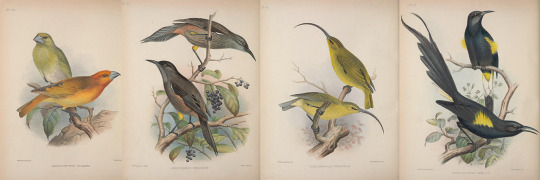
Extinct Hawaiian Honeycreepers (Left to Right): Greater Koa Finch (Rhodacanthis palmeri), Kauai 'O'o (Moho braccatus), Hawaii 'Akialoa (Hemignathus obscurus), Hawaii 'O'o (Moho nobilis)
From: Birds of the Sandwich Islands, By Wildon Scott (1899)
Courtesy of the Smithsonian Institute
In the early 1900’s, a silent killer began stalking the natural and cultural heritage of Hawaii. From the mountains to the shoreline (mauka to makai) the forests of Hawaii were falling silent. Something was killing Hawaii’s honeycreepers - a unique family of birds not found anywhere else on the planet.
The ancestors of the honeycreepers arrived on the newly formed Hawaiian islands millions of years ago and quickly evolved to fill the empty landscape with dozens of new and unique species, a process called adaptive radiation.
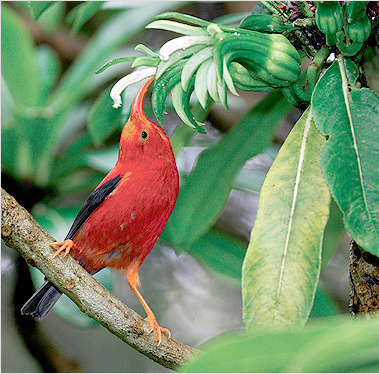
An feeds i’iwi on a lobeliad flower. Photo Credit: Jack Jeffrey
Naturalists began to record the disappearances of many endemic Hawaiian species in the late 1800’s. Habitat loss and introduced predators like cats, rats, and pigs were taking their toll on all of the native plant and animal populations.
But as the decades passed and the species continued to disappear, it seemed as if something other than habitat loss and predation was impacting Hawaii’s birds - particularly the honeycreepers. The huge flocks of ‘I’iwi that once roamed the mountainsides foraging for food had disappeared, even from seemingly pristine lowland forest.

Endangered Hawaiian Honeycreepers (Left to Right) Akiapolaau © Jack Jeffrey Photography, Akohekohe © Jack Jeffrey Photography, Amakihi © Jack Jeffrey Photography, Hawaii Akepa © Jack Jeffrey Photography
By the 1960’s biologist Richard Warner believed he had identified the culprit. The answer lay in the pattern of disappearance. The birds were disappearing from healthy lower elevation forests but were still present in the higher elevation forests where the temperatures were cooler. Whatever was killing the birds, it was only happening at lower elevations. The culprit, he theorized, was a disease found commonly in bird species across the planet - mosquito borne avian malaria.
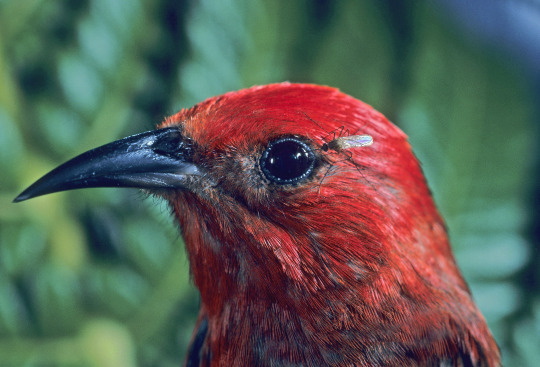
Apapane with a mosquito. Photo © Jack Jeffrey Photography
Avian malaria itself probably came to Hawaii in the early 1900’s when domesticated birds were imported into the lowland cities. These introduced birds almost certainly carried avian malaria, but the disease never would have spread to the native bird population if it hadn’t been for another earlier invader - the mosquito Culex quinquefasciatus. The Culex quinquefasciatus species is the only known vector of avian malaria. Without Culex, the disease cannot spread.
In the vast majority of bird species, the parasites (members of the genus Plasmodium) have little to no impact on the health of the infected birds. Long exposure to the parasite has allowed most species around the world to evolve effective disease resistance.
For many of Hawaiiʻs forest birds, which evolved in the isolation of the world’s most remote archipelago without exposure to malaria or mosquitoes, the impacts have been catastrophic. Wherever the forest birds range overlapped with mosquito populations, the birds have disappeared.
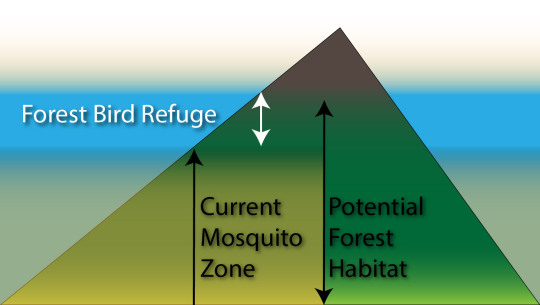
Mosquitos breed and thrive at lower and warmer elevations where they infect birds with avian malaria and pox. Higher and cooler elevation forests, where mosquitoes and their diseases do not thrive, have become the only refuges for Hawaii’s forest birds, but even those areas are now under threat. As temperatures rise, mosquitoes, and the avian diseases they carry, have begun to spread upwards into the mountains further constricting habitat.
“For decades, we had reached this equilibrium. The birds had moved into the upper elevation forests where they had this area of refuge from mosquitoes and avian malaria, but now that's being threatened,” said Josh Fisher, Invasive Species Biologist with the Pacific Islands Fish and Wildlife Office .
Today, nearly every species of Hawaiian honeycreeper is facing shrinking ranges and declining populations. In the last 200 years, 17 out of 41 known species of honeycreeper have gone extinct. Another 14 are endangered. On the island of Kauai, every species of native forest bird is in decline. Ninety percent of the ‘i’iwi’ population is confined to a narrow band of forest on the windward slopes of the island of Hawaii, between 4,000 and 6,000 feet (1,300 and 1,900 meters) in elevation. “We are at this point where some of these populations are so low or so dependent on a single area, that a single catastrophic event could spell the end of a species” said Josh Fisher, Invasive Species Biologist with the Pacific Islands Fish and Wildlife Office .
“There’s an urgency now that didn’t exist before because warming temperatures are already starting to push mosquitoes into the upper elevations of places like Kauai. There really isn't anywhere else for these birds to go. They can't go down and they can't really go up much higher.”
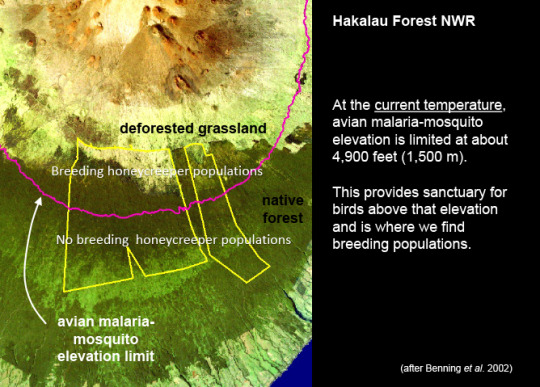
For decades researches have watched as avian malaria reduced bird ranges and pushed population declines across all of the low elevation forests of Hawaii. “We’ve known what the problem is, but with avian malaria there isn't a tool that we can just pull out of a box to fight this. We have to develop the tool,” said Fisher.
Places like Hakalau Forest National Wildlife Refuge are tackling habitat loss by aggressively planting native species and restoring forests. James Campbell National Wildlife Refuge and Kilauea Point National Wildlife Refuge are using predator proof fences to keep out invasive predators and protect birds. But introduced diseases are more difficult to address. “Fortunately over last decade there have been significant advances in how to address mosquitoes at the landscape scale,” said Fisher.
Biologists and conservationists across Hawaii are working to find ways to save the honeycreepers: from dealing with predation by introduced species to landscape scale control of mosquitoes. Now more than ever, it is important to work with our partners to protect these species for future generations.
This story is part of a series examining the issues impacting Hawaii’s forest birds. Read the other stories in the series here.
Hawaii’s Magnificent Forest Birds
ʻŌhiʻa lehua: the Foundation of Hawaii’s Forest Ecosystem
Want to dive deeper?
Collapsing avian community on a Hawaiian island
Paxton, Eben; Camp, Richard J.; Gorresen, P. Marcos; Crampton, Lisa H.; Leonard, David L.; VanderWerf, Eric
Abundance, distribution, and population trends of the iconic Hawaiian Honeycreeper, the ʻIʻiwi (Vestiaria coccinea) throughout the Hawaiian Islands
Paxton, Eben H.; Gorresen, P. Marcos; Camp, Richard J.
Large-Scale Range Collapse of Hawaiian Forest Birds under Climate Change and the Need 21st Century Conservation Options.
Fortini LB, Vorsino AE, Amidon FA, Paxton EH, Jacobi JD
For more stories of conservation in the Pacific, follow https://www.facebook.com/pg/PacificIslandsFWS
#hawaii#Hakalau Forest#Hakalau national wildlife refuge#iiwi#Forest#forestbird#honeycreeper#hawaiian honeycreeper#maui#kauai#oahu#evolution#science#conservation#endangered#endangered species#USGS#avian malaria#birds#Birdwatching#birding
122 notes
·
View notes
Video
'I'iwi - Vestiaria coccinea by USFWS - Pacific Region
Via Flickr:
This nectar feeding member of the honeycreeper family, with its brilliant scarlet body plumage and black wings and tail, abounds in the forest canopy where ‘ōhi‘a lehua blossoms are plentiful. The ‘i‘iwi's long, down curved, orange bill is specialized for sipping nectar from tubular flowers. The ‘i‘iwi’s "squeaky hinge” call can be heard throughout the forest when the birds are present. Learn more at bit.ly/ForestBirds_1 bit.ly/ForestBirds_2 bit.ly/ForestBirds_3
#Hawaiian Islands#Hawaii#Animalia#Aves#Chordata#Drepanidinae Vestiaria#Fringillidae#Hawai?i Island#Passeriformes#big island#bird#Hawaiʻi Island#iiwi#Hakalau#Forest
4 notes
·
View notes
Photo

Yes...miracles still happen everyday.
1 note
·
View note
Link
There’s a interactive report embedded within this linked article that has several maps of some of the National Wildlife Refuges and some of their inhabitants. Excerpt from this article from Defenders of Wildlife:
Imperiled species rely on national wildlife refuges to shelter them from underlying threats driving the global biodiversity crisis. While the awe-inspiring beauty of the refuges attracts many human visitors, the mission of the refuge system goes hand in hand with the goals of the Endangered Species Act (ESA): protect species and their habitats.
Imperiled species rely on national wildlife refuges to shelter them from underlying threats driving the global biodiversity crisis. While the awe-inspiring beauty of the refuges attracts many human visitors, the mission of the refuge system goes hand in hand with the goals of the Endangered Species Act (ESA): protect species and their habitats.
We have known about the special relationship between the ESA and refuges for decades, but unfortunately there has been no robust tally of how many threatened and endangered species are found on refuge land. So Defenders of Wildlife and the National Wildlife Refuge Association teamed up to figure it out by poring over hundreds of federal documents to develop an up-to-date list of species found on or dependent on units of the National Wildlife Refuge System.
What we found is astounding: 513 ESA-listed species are found or are dependent on at least 444 refuges.
As the first nation to develop a formal network of protected areas, the U.S. led the way in protecting the landscape for our iconic wildlife. Today, the National Wildlife Refuge System includes some 568 national wildlife refuges, dedicating 95 million acres of land and 760 million acres of submerged lands and waters as a sanctuary for our nation's wildlife. Every state and U.S. territory has at least one wildlife refuge, and most major US cities are within an hour's drive of one. Many of these refuges are the only place in the world--or a critical stronghold--for species on the edge of extinction. Some refuges harbor a particularly high diversity of ESA-listed species, underscoring their importance not just to species like whooping crane and red wolf, but all biodiversity. Hakalau Forest National Wildlife Refuge in Hawaii and Key Deer National Wildlife Refuge each host over 30 federally listed species!
8 notes
·
View notes
Photo

'Ōhi'a Lehua (via USFWS - Pacific Region)
Metrosideros polymorpha
Ōhi‘a trees are the foundation of native Hawaiian forests like Hakalau Forest National Wildlife Refuge and throughout Hawaiʻi. Many native bird species depend on ʻōhiʻa.
Ōhi‘a trees are under threat from a poorly understood and newly identified, rapidly-spreading fungal disease (Ceratocystis spp.) that kills native ‘ōhi‘a trees.
Learn more www.rapidohiadeath.org
Photo by Eric Hunt
CC BY-NC-ND 2.0
www.flickr.com/photos/ericinsf/223724294
#'Ohi'a Lehua#Metrosideros polymorpha#Metrosideros#Myrtaceae#Myrtales#flowers#trees#plants#ecology#conservation#Hawaii
28 notes
·
View notes
Text
theridion grallator

hawaiian happy face spiders are just five millimetres long and live in the rainforests of o’ahu, moloka’i, maui and the island of hawai’i at elevations of 980-6,550 feet high. they live beneath the leaves of plants where they spin small webs and hide during the day.
unfortunately, these spiders are endangered and are not covered under any specific protective programs. only a few of the many threatened arachnids in the region benefit directly from conservation efforts, so this is not surprising. thankfully, the species does occur in one protected area - the hakalau forest national wildlife refuge of hawai’i.
mothers will actively care for their offspring. they will lay one egg sac and will only lay another if the first is lost. the sac is guarded aggressively and will not survive without the mother’s protection. maternal care continues after the babies hatch, with the young feeding together on prey caught for them by the mother. spiderlings are adopted into the broods of unrelated females if their own mother dies. this even occurs if the spiderling looks completely different from the adoptive mother. the adoptive mother treats her new spiderlings like her own, actively catching food for them and protecting them from predators.

the spider has a base colour of translucent yellow. red, black and white colour patterns are superimposed on the base colour. the most prominent colour morph is patternless or only has a few small black dots, but patterned morphs are highly diverse and live up to the name given to the species. some blue individuals have been reported. they are even able to change colour depending on what they eat. a field study found that orange spiders had eaten small flies and other spiders, dark orange spiders had eaten moths, green had eaten caterpillars and lastly, some dark chocolate brown individuals were collected but it was unknown what they had consumed. the most frequent colour change is from translucent yellow to orange because they predominantly feed on small dipterans, which make up about 70% of the diet. these colour changes would last for a minimum of two days and a maximum of seven, with the brown colouration lasting longest.
#spiders#arachnology#spiderblr#arachnophobia#hawaiian happy face spider#theridion grallator#mine#entomology
58 notes
·
View notes
Text
Why Should You Visit Hakalau Forest
Hakalau Forest is a very famous spot in the state of Hawaii. It's a crucial part of the island's history, and it has been designated as a National Historic Landmark. Alongside being an important historical site, Hakalau Forest offers amazing natural beauty and attracts thousands of visitors every year. What makes this place special? Have a look at these eight reasons why you should visit Hakalau Forest today! Hakalau Forest has many historic spots that are loved by people who visit and even locals.

Throughout the forest, you can see old fish ponds, taro patches, trails used for hunting burial sites, burial grounds, and shelter caves. These features helped shape the landscape of this island as well as highlighting how different cultures have been able to adapt to life here in Hawaii. One of the greatest things of visiting Hakalau Forest is enjoying its natural beauty. There are plenty of activities to enjoy, such as hiking or biking on one of the thirteen miles of trails in this area. If you're feeling adventurous, you could even walk through a bamboo grove which is situated near the stream!
The famous Nene (Hawaiian Goose) and Kioea (Bald Eagle) can also be found here in winter. The majority of these birds are free to roam the forests of the island, but the majority of them spend time in Hakalau Forest National Wildlife Refuge. If you'd prefer to see them up close There are a handful of hiking trails (all of which are located inside the forest) which you can hike to take in these creatures in their natural surroundings. The refuge contains around 2,000 acres of the forest, yet only .75 miles are accessible to visitors.
The trail begins close to the ranger station and takes roughly an hour to walk. The majority of hikes ending on a cliff from where hikers can enjoy the views of Hakalau Forest Valley, which is adjacent to it. The trail is quite muddy during certain seasons which is why you must have sturdy shoes or boots prior to starting this trek. If you're in search of butterflies, this hike offers great chances. If you're looking to spot birds, they typically perch inside the trees here which means that any noise you hear could potentially catch their attention.
The forest roads is also used by hunters in the time of game bird seasons. And since you're already so in close proximity to the sea, it's simple to add a few hours of beach time in your visit. Just head over to the nearby Nanawale Beach Park on the Puna coast to enjoy a refreshing snorkeling session or surfing along the Pacific with views of Mauna Kea in the distance! Amongst all of it's beauty in nature, Hakalau Forest is most well-known for its abundance of birds. They are everywhere!

A few options are The Pu'u O Kona Viewpoint Trail, or Pua Mau Place Hiking Trail. Pua Mau Place hiking trail. Both hikes provide stunning views that will leave you in awe! No matter which one you decide to take, be sure to wear proper footwear as some of the trails can be quite slippery. Don't forget to bring some water, too. At the very least, three major watersheds run through this forest, and you'll need to drink plenty of water during your hike!
1 note
·
View note
Photo

Make your donation—ANY AMOUNT— go TRIPLE the distance with this stellar match! If you've been thinking about making a donation, NOW is a phenomenal time to do so. An anonymous donor will match all received donations between now & December 31st, up to $15,000. AND: I'll match dollar for dollar up to $100!!! December 1, 2020, is Giving Tuesday and Wilderness Volunteers has been in the midst of a massive 2020 fundraiser to help us offset the lost income due to the pandemic. We're currently at $60,516 of our fundraising goal of $75,000 by December 31st. https://www.facebook.com/donate/721365672093102/ (at Hakalau Forest National Wildlife Refuge) https://www.instagram.com/p/CIQtDV7H4ed/?igshid=a0m583bi89c4
0 notes
Photo
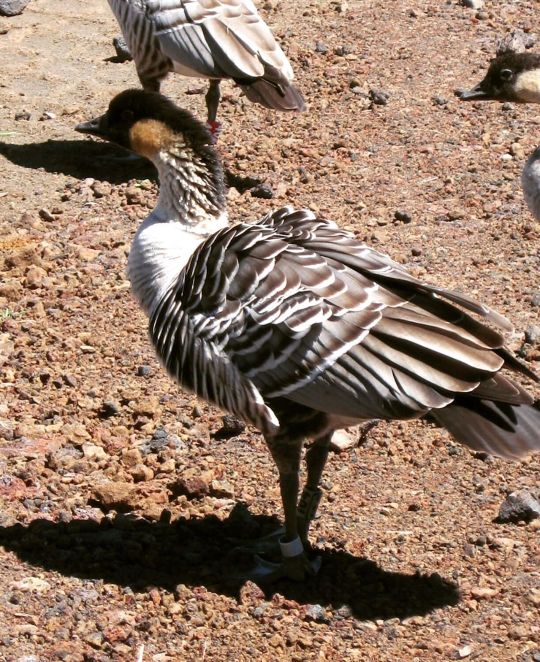
The Hawaiian Nēnē goose on the lower slopes of Mauna Kea for #FowlFriday! The nēnē on the Big Island of Hawai'i is a success story of species recovery efforts...(& many were banded/ringed by one person...Jack Jeffrey, who I had the honour of birding with when this photo was taken)! #nene #hawaiiangoose #goose #birdsofhawaii #endangeredspecies #speciesrecovery #conservation #bigisland #hawaii #fowl #birds #birding #birdtherapy #birdwatching #birdphotography #wildlifephotography #naturephotography (at Hakalau Forest National Wildlife Refuge) https://www.instagram.com/p/CB56q9jgh-0/?igshid=1mwsi3r4md663
#fowlfriday#nene#hawaiiangoose#goose#birdsofhawaii#endangeredspecies#speciesrecovery#conservation#bigisland#hawaii#fowl#birds#birding#birdtherapy#birdwatching#birdphotography#wildlifephotography#naturephotography
0 notes
Text
‘I‘iwi Receives Protection under the Endangered Species Act

Photo Credit: Dan Clark/USFWS
Once one of the most common forest birds in the Hawaiian Islands, the ‘i‘iwi, also known as the scarlet honeycreeper, will now be protected as a threatened species under the Endangered Species Act.
In the past, ‘i‘iwi could be found from the coastal lowlands where they foraged for food to the high mountain forests where they nested. Today, ninety percent of the ‘i‘iwi population is confined to a narrow band of forest on East Maui and the windward slopes of the island of Hawaii, between 4,265 and 6,234 feet (1,300 and 1,900 meters) in elevation. The birds are virtually gone from the islands of Lanai, Oahu, Molokai and west Maui, while the population on Kauai is in steep decline.

(This map shows approximate ranges and should not be used for planning purposes.)
“In recent years, the ‘i‘iwi population has been in sharp decline, due to threats from habitat loss, invasive species and avian diseases, particularly avian malaria,” said Mary Abrams, project leader for the Service’s Pacific Islands Fish and Wildlife Office. “These threats have affected all forest birds, not just the ‘i‘iwi. Conservation that benefits the ‘i‘iwi will undoubtedly benefit other Hawaiian forest birds.”
Avian malaria, carried by invasive mosquitos, is the primary driver in the decline in of the ‘i‘iwi population, and has already caused the decimation of dozens of other Hawaiian forest birds. The disease kills approximately ninety-five percent of infected ‘i‘iwi. Mosquitos, which are not native to the Hawaiian Islands, breed and thrive at lower and warmer elevations where they infect birds like the ‘i’iwi with avian malaria and pox.

“‘I‘iwi have virtually disappeared from any habitat where mosquitoes are found,” said Abrams. “This has caused their range to shrink dramatically – they are almost entirely limited to higher elevation ‘ōhi‘a forests for their habitat, dietary, and nesting needs.
Higher and cooler elevation ‘ōhi‘a forests, where mosquitoes do not thrive, remain the only habitat for the ‘i‘iwi, but even those areas are under threat. As temperatures rise, mosquitoes, and the avian diseases they carry, are able to survive at higher elevations and spread upwards into the mountains, further constricting the ‘i‘iwi’s range.

‘I’iwi in ohia lehua. Photo Credit: Raymond Lara/USFWS
‘I‘iwi are dependent for their survival on forests of native ‘ōhi‘a. On the island of Hawaii, home to 90 percent of the remaining ‘i‘iwi population, those ‘ōhi‘a forests have been under attack from rapid ‘ōhi‘a death, an invasive tree pathogen.
“Working with the state, our conservation partners and the public will be crucial as we work to recover the ‘i‘iwi, said Abrams. “The Service is committed to building on our record of collaborative conservation to protect Hawaii’s native species.”
The Service’s final listing rule will be published in the Federal Register on Sept 20, 2017, and will become effective on October 20, 2017. Next steps include development of a recovery plan, which will be bolstered by input from other federal and state agencies, other conservation partners and the public.
<<This article has been edited to correct the date on which the rule will become effective, which was incorrectly stated as September 20th.>>>
More information about the final listing.
More photos of the ‘i’iwi.
Official News Release
Read more stories about issues facing forest birds.
Hawaii’s Magnificent Forest Bird
ʻŌhiʻa lehua: The Foundation of Hawaii’s Forest Ecosystem:
Mysterious Disease Threatens Critical Hawaiian Forests
What’s Killing Hawaii’s Forest Birds
#hawaii#u s fish and wildlife#iiwi#conservation#endangered species#endangered species act#threatened#forests#national park service#forest service#USGS#USFWS#National Wildlife Refuge#Hakalau Forest#oahu#maui#kauai#forest birds#birdi#birds#Birdwatching#avian malaria#rapid ohia death
103 notes
·
View notes

